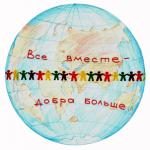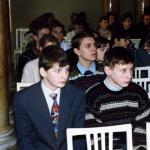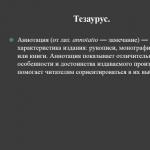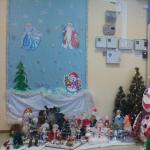Annotation examples. Annotation to the presentation "The revival of an original craft How to start an annotation
slide 1
annotation
slide 2

Thesaurus.
Abstract (from lat. annotatio - remark) - a brief description of the publication: manuscripts, monographs, articles or books. The abstract shows the distinctive features and advantages of the published work, helps readers to navigate in their choice.
slide 3

Annotation types
annotation
Bibliographic description: Abstract text:
-Author, -Genre of the work; -name, -characters; - publishing house, - time and place of action; - year of publication, - summary; -number of pages, -topic; - the presence of illustrations. -problematics; -destination.
slide 4

Determining Significance
The significance of the annotation is determined by the fact that it should draw the attention of the buyer to the book, revealing its main content, the peculiarity of this particular edition of the book. The abstract also reflects additional information that is not in the bibliographic description. The abstract is placed after the bibliographic description from the paragraph. The abstract is always written in Russian, regardless of the text of the publication. The text of the abstract should be concise and clear, free from secondary information. The annotation answers the question: “What is the primary document talking about?”
slide 5

Annotations can be conditionally divided into two groups:
Annotations on literary and artistic works; Annotations for non-literary-art publications.
slide 6

Annotations on literary and artistic works include the following information:
Information about the author (belonging to a certain time, nationality, authorship of other works); Information about the author in the abstract should be given only if the author has a scientific degree or the title of academician, professor, doctor or candidate of science, as well as a well-known scientist or practitioner. For example: "Doctor of Medical Sciences, professor offers a new method of healing ...", "The manual was written by the RAMS team, edited by an academician ....". genre of the work(s); the main theme and problem of the work, the place and time of the described events; reader's address (for publications for children).
Slide 7

It is advisable to indicate in the annotation the general storyline, intrigue, plot plot. It is useful to indicate in the annotation the date of creation of the work, if it is given in the publication. It is advisable to use a generalized indication of the topic of the book when preparing an annotation for publications on natural science, technical subjects (for an extended, competent annotation, in this case, special knowledge is required).
Slide 8

An abstract in a book usually consists of two parts. The first part formulates the main theme of the book, article; the second part lists (names) the main provisions. The subject of the action in the annotation is usually not named, because it is clear, known from the context; passive constructions (verbal and participial) are used more actively.
Slide 9

The annotation for publications, except for literary and artistic ones, includes the following information:
a brief disclosure of the topic of the publication (reflection of the specifics of the content, general theme or general idea); differences of the publication from other, related in subject matter and / or from previous editions of the works of the same author (novelty of the content, coverage of unknown facts or originality of their interpretation); purpose and reader's address of the publication; type of publication (according to GOST 7.60) or genre of the published work; change in the title of the document or the group of authors and the year of release of the previous edition (when republishing).
Slide 10

Annotation Samples:
Frolov I.G. Global problems, man and the fate of mankind // Philosophy and politics in the modern world. - M.: Nauka, 1989. - S. 44-60. The article is devoted to the influence of global problems on various aspects of human life and on the issue of the future of civilization. The article discusses the ways and methods of solving global problems by thinkers of various directions. “This book is the first Russian translation of a dictionary-reference book on the history of geographical discoveries and research. It contains biographies of more than three hundred outstanding travelers and navigators of all times and peoples.
, GBOU secondary school No. 000, St. Petersburg
ID: 239 - 822 - 464
Annotation to the presentation
Training program:"History and culture of St. Petersburg"
Development destination: 7th grade students
Program section:"Our land to the founding of St. Petersburg" (from ancient times to 1703)
Presentation topic:"The first inhabitants of our region"
Development genre: Power point presentation
Purpose of the presentation: To form a holistic view of the tribes that lived in ancient times on the territory of our region.
Presentation objectives:
1. Contribute to the formation of a holistic view of the first inhabitants of our region
2. Update the knowledge of students obtained earlier.
3. Give the opportunity to independently acquire knowledge, draw conclusions using various types of tasks.
4. To assist not only in conducting, but also in preparing for the lesson, as the hyperlinks provide additional material at the discretion of the teacher
This presentation fully complies with the structure of the obligatory part of lesson No. 2 of the section of the program “Our region before the founding of St. Petersburg” according to the workbook, Lebedeva has long been on our lands ... (Series “Pages of the life of the region”, St. Petersburg: SMIO Press, 2010. - 40p.)
and is built according to the following plan:
Sites of ancient people on the territory of our region
The resettlement of the Finno - Ugric tribes, the arrival of the Slavs to the lands of the North - West
Occupations of the inhabitants of the region
Beliefs of the first inhabitants of our region.
Change of paganism by Christianity
Finno-Ugric tribes today (this section is optional)
The presentation is completely ready for use in the classroom, and the teacher is given the optimal choice of the amount of material that is needed for the level of each class.
1. The presentation was made in Power Point - 2003. Includes fragments using animation, hyperlinks to text fragments (placed in the presentation itself), a music fragment in MP format - 3
(Karelian folk song performed by the PSU choir), fragments from the films "Sadko" (1952, director A. Ptushko) and "Vasily Buslaev" (1982, director G. Vasiliev). The video is presented in the Windows Media program. On slides No. 2, No. 12, No. 17, author's photographs are presented, the poem of slide No. 6 is also the author's.
2. The presentation strictly corresponds to the structure of the lesson in the workbook. On slides No. 3, No. 7, No. 9, No. 11, No. 12, No. 15, the animation “starts” on click. An underscore indicates a hyperlink. If the hyperlink is not used, you can go to the next slide using the arrow in the lower right corner. Slide 9 shows the problematic task. The central children's drawing opens automatically, as the students name the occupations of the first inhabitants according to the drawing, the teacher opens the rest of the pictures. You can also ask what occupations are not shown in the figure (flightkeeping, piloting). And then - the transition to viewing a fragment from the film "Sadko".
3. The structure of slide No. 15 (and hyperlinks to it) is aimed at updating the knowledge gained earlier (in grade 6 at the course "St. Petersburg - city - museum, part III")
4. On slides No. 6, No. 19, the animation "starts" automatically. The materials of these slides are more designed to have an emotional impact on students.
5. Slide number 18 contains a problematic question, the answer to which students will give after analyzing the table materials.
I hope that this presentation will be useful for teachers of history and culture of St. Petersburg, history teachers.
In ordinary life, we periodically encounter the need to read annotations: when searching for the necessary information, when there is no time to familiarize ourselves with a scientific work or article, and most often, to understand whether it is worth spending time on the proposed material.But what to do when you are the author of an article and there is an urgent need to make a competent annotation to it. This is where the question arises, which in importance is comparable only to the question “How to write a resume?”. After all, in any case, the goal is one - to interest.
To begin with, let's define that any annotation is a characteristic that reveals the most basic in the text. The main thing in it is that a person, having run his eyes over a small text, would want to read the entire article.
So, when writing an abstract for an article, observe the following requirements:
- Before writing an annotation, carefully read the entire article.
- In the abstract, do not retell the text, depriving the reader of the need to read the article. Do not forget that your task is to interest the reader.
- Do not express your opinion about the article in the abstract.
- Keep your main ideas short. In the text, use the verbs “proves, analyzes” or the phrases “the article substantiates, sets out, pays special attention.
- In addition, the abstract should be concise, easy to understand and maintain a neutral, artistic or scientific style of presentation.
- Be sure to indicate the circle of readers who will be interested in this article.
- When writing an abstract, avoid complex sentences. Write in an accessible and understandable language for any audience
- IMPORTANT! Annotation to the article should be short – no more than 5-6 sentences.
- Remember that a well-written abstract will help the reader make the right decision: be sure to read your article.
Sample 1
This presentation is a visual material for a geography lesson (it could also be appropriate for a German lesson when getting acquainted with German-speaking countries). The presentation gives brief information about Austria, the capital of the state, currency, language, population, neighboring states and geographical location, political structure, state symbols, natural and architectural attractions of Austria, its history, culture and culinary features, as well as about world-famous people and sports. This presentation must be accompanied by the text of the attached abstract.
The slides contain a large number of illustrations characteristic of the state, allowing you to visually capture the information and assimilate it.
Sample 2
This abstract can be used for classes in the theater studio and in extracurricular work on the subject of "Russian language". The educational event is held in an unconventional form. The generalization and consolidation of knowledge gained by students in school lessons and in extracurricular activities is carried out in a relaxed atmosphere. The lesson is built on the elements of moderation technology using AMO (active learning methods); The topic is included in the "Writing" section.
Sample 3
The article tells about spiritual and moral education as a factor in the spiritual health of schoolchildren (on the example of the school museums "Feat of Mercy" and "Room-museum of the family of IP Pavlov").
An example of the spiritual and moral development and education of students is the creation of the museum "The Feat of Mercy" and the "Room Museum of the Family of IP Pavlov."
The purpose of museums is to educate children in mercy, kindness, respect for the sick, suffering people, love for the fatherland, for their family, for comrades.
The article describes the experience of the museum. In addition to excursions, lessons and class hours, literary and musical compositions, memory lessons dedicated to scientists are being practiced; lessons of courage dedicated to the participants of the Great Patriotic War, etc. A project of "class meeting hours" dedicated to various cultural events and memorable dates has been developed. The article also tells about the plans for the development of the school museum in the near future.
slide 2
Read the dictionary entry: ANNOTATION (from the Latin annotation - note, note) - a summary of the content of a book, article, manuscript. It may also contain an assessment of the work, information about the author, about the creative history of the work. What is an annotation?
slide 3
What is an annotation? What information can be included in an abstract? Use the annotation definition as well as the following annotations to answer:
slide 4
Mertlik R. Antique legends and tales. / Per. from Czech. – M.; Respublika, 1992. - 479 pp. The book by R. Mertlik, a well-known specialist in ancient literature, contains the most famous ancient Greek myths that have fascinated people for centuries. They are the basis of Western European culture and still inspire writers, poets and artists. Getting to know them will give you many pleasant moments. Designed for a wide range of readers.
slide 5
Annotations are different.
Review the diagram. What are the types of annotations? ABSTRACT Reference ("purely" informative) Recommendation with elements of evaluation From the publisher From the author From the compiler
slide 6
On what grounds are the varieties of these secondary texts singled out? ABSTRACT Reference ("purely" informative) Recommendation with elements of evaluation From the publisher From the author From the compiler
Slide 7
Highlight the supporting structures - standard and non-standard (unusual) expressions - in each group of words.
General characteristics of the book (collection) The book contains ... (Stories, novels, The book includes ... articles, fairy tales The collection includes ... etc.)
Slide 8
A D R E S A T Girls and boys! Moms and dads! Grandparents! The book is addressed to... This book can be recommended... The book is intended for a wide range of readers.
Slide 9
I will be glad and grateful, guys, if you read this little book. It is about curiosity, about what is seen around us. Please read this book! Let's open the book together and read it soon! Call to read
Slide 10
The task is to interest This story was told to me by a man who ... He struck me with the fact that ... Well, what happened next, you will find out if you read this book ... This story is full of the most incredible events and adventures ...
slide 11
Guess why there is space in each column? Of course, you can come up with your own version! (Create a document in which you offer your options. You can arrange it in the form of a table)
slide 12
Annotating new editions
Well ... This task is not easy, because you will have to write an annotation for the story "Boys" by Fyodor Mikhailovich Dostoevsky. Make it so that the one who reads your annotation will definitely want to get acquainted with this work. (This is not the last slide).
slide 13
All in the same document, print the annotation. What? No, you won’t take it home, we do everything in the classroom. And you have the seventh lesson. Did not have time? There is only one conclusion: you work slowly, chat a lot and get distracted. What are you! I love you very much... Oh! I made a promise to myself… Aha! Take advantage of the fact that I can not answer you. Of course, it's easy to argue with a voiceless teacher. Just do not forget that you are working for the assessment!
View all slides





